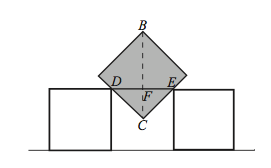2005 AMC 10A Problems/Problem 19
Problem
Three one-inch squares are placed with their bases on a line. The center square is lifted out and rotated ![]() , as shown. Then it is centered and lowered into its original location until it touches both of the adjoining squares. How many inches is the point
, as shown. Then it is centered and lowered into its original location until it touches both of the adjoining squares. How many inches is the point ![]() from the line on which the bases of the original squares were placed?
from the line on which the bases of the original squares were placed?
![[asy] unitsize(1inch); defaultpen(linewidth(.8pt)+fontsize(8pt)); draw((0,0)--((1/3) + 3*(1/2),0)); fill(((1/6) + (1/2),0)--((1/6) + (1/2),(1/2))--((1/6) + 1,(1/2))--((1/6) + 1,0)--cycle, rgb(.7,.7,.7)); draw(((1/6),0)--((1/6) + (1/2),0)--((1/6) + (1/2),(1/2))--((1/6),(1/2))--cycle); draw(((1/6) + (1/2),0)--((1/6) + (1/2),(1/2))--((1/6) + 1,(1/2))--((1/6) + 1,0)--cycle); draw(((1/6) + 1,0)--((1/6) + 1,(1/2))--((1/6) + (3/2),(1/2))--((1/6) + (3/2),0)--cycle); draw((2,0)--(2 + (1/3) + (3/2),0)); draw(((2/3) + (3/2),0)--((2/3) + 2,0)--((2/3) + 2,(1/2))--((2/3) + (3/2),(1/2))--cycle); draw(((2/3) + (5/2),0)--((2/3) + (5/2),(1/2))--((2/3) + 3,(1/2))--((2/3) + 3,0)--cycle); label("$B$",((1/6) + (1/2),(1/2)),NW); label("$B$",((2/3) + 2 + (1/4),(29/30)),NNE); draw(((1/6) + (1/2),(1/2)+0.05)..(1,.8)..((2/3) + 2 + (1/4)-.05,(29/30)),EndArrow(HookHead,3)); fill(((2/3) + 2 + (1/4),(1/4))--((2/3) + (5/2) + (1/10),(1/2) + (1/9))--((2/3) + 2 + (1/4),(29/30))--((2/3) + 2 - (1/10),(1/2) + (1/9))--cycle, rgb(.7,.7,.7)); draw(((2/3) + 2 + (1/4),(1/4))--((2/3) + (5/2) + (1/10),(1/2) + (1/9))--((2/3) + 2 + (1/4),(29/30))--((2/3) + 2 - (1/10),(1/2) + (1/9))--cycle);[/asy]](http://latex.artofproblemsolving.com/a/7/c/a7cc2885a1128684338473a8a960bdd8b0ed372f.png)
![]()
Solution
The rotated middle square is lowered until it touches both the adjoining squares, so since the horizontal distance between those squares is ![]() inch, the middle square will stop being lowered once the length
inch, the middle square will stop being lowered once the length ![]() in the diagram below is
in the diagram below is ![]() inch. Now, since
inch. Now, since ![]() and
and ![]() respectively pass through the vertices
respectively pass through the vertices ![]() and
and ![]() of the horizontal middle square, and intersect at right angles, they must be the diagonals of the horizontal middle square, so
of the horizontal middle square, and intersect at right angles, they must be the diagonals of the horizontal middle square, so ![]() is a
is a ![]() triangle.
triangle.
It follows that when ![]() , we have
, we have ![]() , and as the middle square was rotated by exactly
, and as the middle square was rotated by exactly ![]() from its original horizontal position, the diagonal
from its original horizontal position, the diagonal ![]() is now vertical, giving
is now vertical, giving ![]() . This means
. This means ![]() and
and ![]() are also
are also ![]() triangles, and hence
triangles, and hence  .
.
Lastly, since ![]() is the diagonal of a unit square, its length is
is the diagonal of a unit square, its length is ![]() (by Pythagoras' theorem), so we deduce that the distance from
(by Pythagoras' theorem), so we deduce that the distance from ![]() to the bottom horizontal line is
to the bottom horizontal line is
![]()
(An alternative for this last step is to compute the distance from ![]() to the bottom horizontal line as
to the bottom horizontal line as ![]() , so that the distance from
, so that the distance from ![]() to the bottom horizontal line is, once again,
to the bottom horizontal line is, once again, ![]() .)
.)
See Also
| 2005 AMC 10A (Problems • Answer Key • Resources) | ||
| Preceded by Problem 18 |
Followed by Problem 20 | |
| 1 • 2 • 3 • 4 • 5 • 6 • 7 • 8 • 9 • 10 • 11 • 12 • 13 • 14 • 15 • 16 • 17 • 18 • 19 • 20 • 21 • 22 • 23 • 24 • 25 | ||
| All AMC 10 Problems and Solutions | ||
These problems are copyrighted © by the Mathematical Association of America, as part of the American Mathematics Competitions. ![]()










